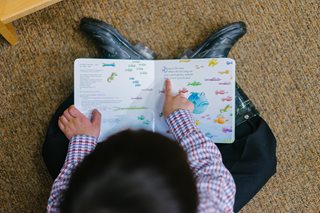 A time honored tradition, making New Year’s resolutions is something many people participate in every year. With a new year comes the chance for a new you, an opportunity to improve yourself. That could be deciding to start working out, getting yourself out of debt, or pick up a new hobby. All wonderful ways to improve yourself.
A time honored tradition, making New Year’s resolutions is something many people participate in every year. With a new year comes the chance for a new you, an opportunity to improve yourself. That could be deciding to start working out, getting yourself out of debt, or pick up a new hobby. All wonderful ways to improve yourself.
But New Year’s isn’t just for you. Do you have children who want to participate in this reason for self-improvement? Maybe they see you planning out your resolutions and want to make a few of their own? That’s wonderful, and you can help them make and keep their resolutions!
Helping Identify Areas They Want To Improve
Your child likely has areas in their own life they want to improve upon, which is great! It’s your job to make sure you don’t take over this step in making resolutions and turn it into what you want them to improve. The only way resolutions can really stick is if the person making the resolution is truly passionate about it. Don’t control the conversation and turn it into, “You need to get better grades and eat better.” Let your child control their resolution making, with you acting as a guide.
Talk with your child about where they want to improve. Make a list and go a little bit into detail. For example, maybe they want to make more friends at school. Rather than just leaving it at that, discuss why they want more friends, what kind of friends they already have, and what kind of new friends they want to make.
Similarly, don’t let resolutions turn into disliking yourself. It’s very easy during this time to focus on things out of our control, physical beauty, or body shaming ourselves, and your child doesn’t need that type of negativity. Focus on self-improvement and growth, not just things we dislike about ourselves.
Likely, it will start with your child giving very broad areas of growth, like being in better shape, or making more friends, and that’s ok. With some extra questions and a little bit of research, you can make a more focused goal and plan.
Making a Firm Goal
 Leaving the goal broad and without detail will almost guarantee it will fail. What does it mean to be in “better shape” or to “start saving money”? You need to set a firm and detailed goal so you have something concrete to work towards, and it’s the same with your child.
Leaving the goal broad and without detail will almost guarantee it will fail. What does it mean to be in “better shape” or to “start saving money”? You need to set a firm and detailed goal so you have something concrete to work towards, and it’s the same with your child.
With their general idea, help them set specific details that mean they reached their goal. If the general goal is to improve their grades, what is the set goal that they need to reach? If they got all B’s last grading period, they could have a goal of all B’s and three A’s. They need that set finish line so they can know if they accomplished their goal.
Just like before, don’t take control of making this firm goal, let it come from your child. Your job is to help guide them to a good goal that will push them a little bit but is still possible. If your child wants to make more friends, don’t let them set the goal of making 100 friends, but instead maybe three or four. The ideal is something that gets them to stretch and grow, but still possible to accomplish.
Setting Sub-Goals
Now that you know the detailed goal your child wants to accomplish, it’s time to set up sub-goals, or waymarkers to track their progress. Still keeping them involved, make smaller goals that will help them reach their final goal, like checkpoints in a long race. That way, they know the path to take to finish their resolution and can measure their progress.
These sub-goals can be their main goal broken up into smaller, easier to manage, chunks, or different goals that contribute in some way to the main goal. A great example of the first goal in getting better grades is identifying key assignments that impact the grades heavily and doing well on those assignments. A good example of the second goal is if a child want to get in better shape, to join an exercise club or sport.
These sub-goals are essential to keeping your child motivated. When a sub-goal is reached, your role is to acknowledge and celebrate it with them! Show them you care about them reaching this checkpoint and talk with them about reaching the next one!
Identify Items Out of Their Control
 There are going to be barriers in your child reaching their goal. Many of those are going to be hurdles your child can jump over and control. Their own time, effort, and resources put into the goal are controlled by them.
There are going to be barriers in your child reaching their goal. Many of those are going to be hurdles your child can jump over and control. Their own time, effort, and resources put into the goal are controlled by them.
But there are going to be some barriers out of their control. If they want to make more friends, they can control who they interact with, but they can’t control the reactions of others. They could be friendly all they want, but some kids might just not want to be friends. Or similarly, they want to get better grades, but if they get sick and end up having to miss classes, it could impact their grades.
Identify potential hurdles for your child and label which ones they can and can’t control. When these hurdles arrive, coach your child through overcoming the ones they can control and find solutions or work arounds for the ones they can’t.
Scheduling Regular Check-ups and Adjusting
Your year could look radically different in June than it did in January, and planning for that potential change is important. You and your child should schedule regular check-ups about their resolution throughout the year to measure progress and discuss any adjustments that need to be made.
A good method for these check-ups is to consulate their goals and sub-goals and discuss how they are feeling with their resolution. Are they farther ahead than anticipated? Are they lagging behind a little bit? Don’t be afraid to adjust those sub-goals to better match the reality of your situation.
Another time to do a check-up is if you see your child’s morale for their resolution drop significantly. It might be they lost their passion, aren’t interested in it anymore, or maybe want to quit because it’s too hard. This can be another time to adjust their goals and try to motivate them. Show them the progress they’ve already made, encourage them to keep pushing, and maybe offer a little extra incentive.
Research and Providing the Right Tools
 Making a solid resolution is more than just willpower and hardwork. It might require some research to know the best ways to succeed, and potentially extra tools and training. If your child wants to make it on their school’s basketball team, but has never played the game before, there’s going to be a necessary research period.
Making a solid resolution is more than just willpower and hardwork. It might require some research to know the best ways to succeed, and potentially extra tools and training. If your child wants to make it on their school’s basketball team, but has never played the game before, there’s going to be a necessary research period.
As the parent, this is a part where you can help a lot. Do the research with your child and help them understand every part of the plan to reach their resolution. If they want to get in better shape, research exercising and nutrition with them. If there is a tool that would help reach their goal, like a gym membership or a personal trainer, you can help facilitate getting it to them.
If your child’s goal is to save money, or something financial related, like buying their first car, Pioneer would love to help! With our Super Star Youth Savings account, your child can have a convenient and safe place to save up their money to reach their goal. A great tool to either reach their goal of just saving more money, or saving up to purchase something special.
Similarly, if your teenage child is wanting to buy their first car, Pioneer’s First-Time Auto Buyer loan can help them understand credit, the car buying process, and give resources for buying their first car!
Apply for a First-Time Auto Buyer Loan